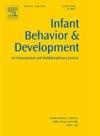观察到的和父母报告的手势对早期干预儿童语言发展的早期贡献
IF 2
3区 心理学
Q3 PSYCHOLOGY, DEVELOPMENTAL
引用次数: 0
摘要
早期的手势使用已被证明可以预测后来的词汇发展。有语言障碍风险的儿童在蹒跚学步时使用的手势通常比正常发育的儿童少。更深入地了解手势在交流中使用的细微差别,有助于对有语言迟缓风险的儿童进行干预。本研究从早期干预项目中招募了83对母子,描述了儿童早期手势行为,并探讨了早期手势对后期语言发展的影响。指示和常规手势类型通过家长报告和游戏中的观察频率进行测量。家长报告与观察到的手势变量有中度相关。结果表明,25个月大的手势对36个月大的语言有独特的影响,超过了25个月大的语言、父母的反应和家庭收入的控制变量。具体而言,父母报告的儿童指示手势和观察到的传统手势是36个月语言的显著预测因素。我们的发现支持了先前关于手势在早期语言发展中的重要性的研究。鼓励父母识别和回应手势可能是一种有效的干预策略,可以增加与有语言迟缓风险的儿童进行积极的亲子沟通的机会。本文章由计算机程序翻译,如有差异,请以英文原文为准。
Early contributions of observed and parent-reported gesture to language development in children enrolled in early intervention
Early gesture use has been shown to be predictive of later vocabulary development. Children at-risk for language impairments often use fewer gestures as toddlers than typically developing children. A deeper understanding of the nuances of gesture use in communication could aid in intervention efforts for children at risk for language delays. In the present study, 83 mother-child dyads were recruited from early intervention programs to describe early child gesture behaviors and investigate the influence of early gestures on later language development. Deictic and conventional gesture types were measured by parent report and observational frequency during play. Parent report and observed gesture variables were moderately correlated. Results indicate that 25-month gesture uniquely contributes to 36-month language, above and beyond control variables 25-month language, parent responsiveness, and household income. Specifically, parent report of child deictic gesture and observed conventional gesture were statistically significant predictors of 36-month language. Our findings support previous research documenting the importance of gesture in early language development. Encouraging parents to recognize and respond to gestures may be an effective intervention strategy to increase opportunities for positive parent-child communication with children at-risk for language delays.
求助全文
通过发布文献求助,成功后即可免费获取论文全文。
去求助
来源期刊

Infant Behavior & Development
PSYCHOLOGY, DEVELOPMENTAL-
CiteScore
4.10
自引率
4.80%
发文量
94
期刊介绍:
Infant Behavior & Development publishes empirical (fundamental and clinical), theoretical, methodological and review papers. Brief reports dealing with behavioral development during infancy (up to 3 years) will also be considered. Papers of an inter- and multidisciplinary nature, for example neuroscience, non-linear dynamics and modelling approaches, are particularly encouraged. Areas covered by the journal include cognitive development, emotional development, perception, perception-action coupling, motor development and socialisation.
 求助内容:
求助内容: 应助结果提醒方式:
应助结果提醒方式:


